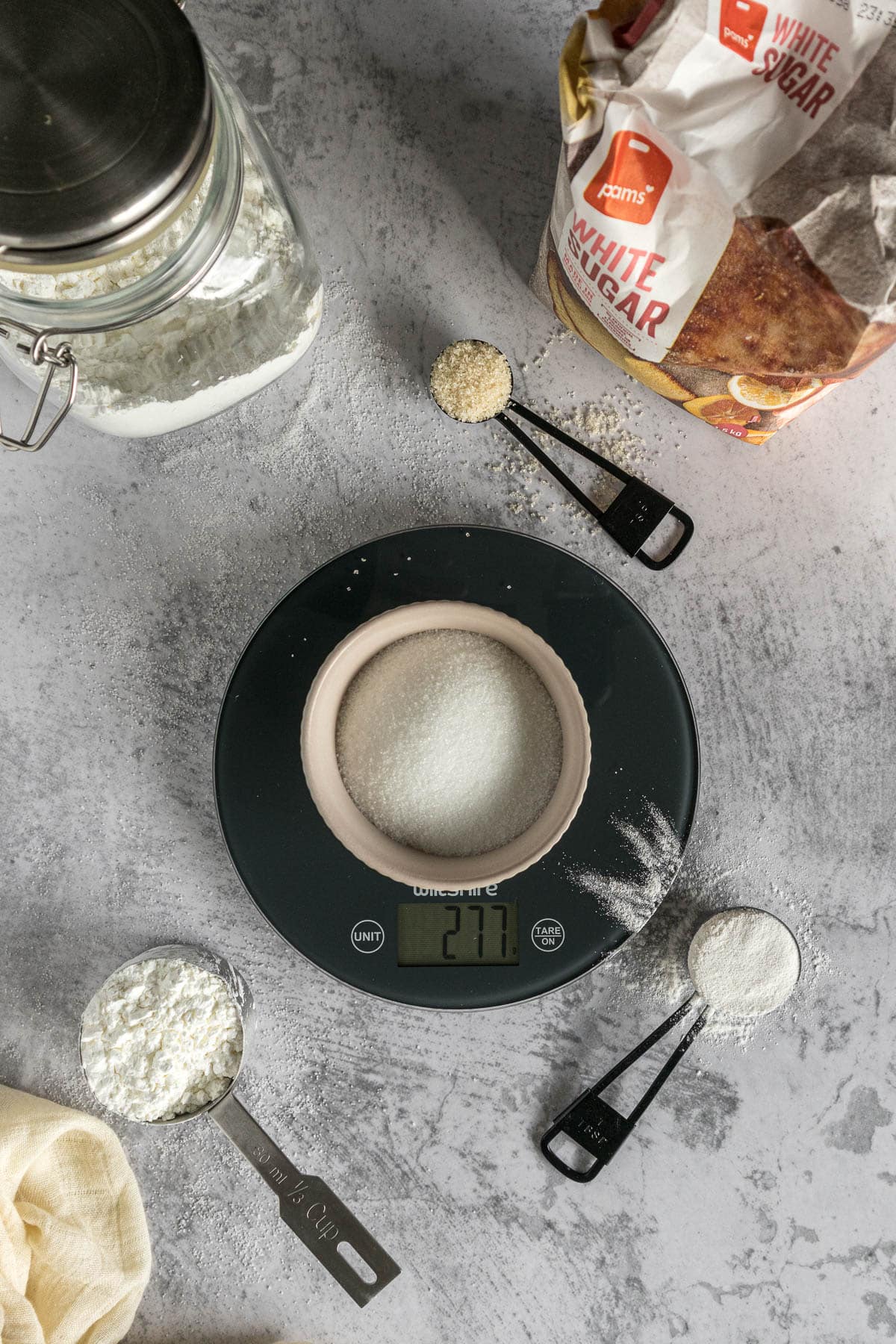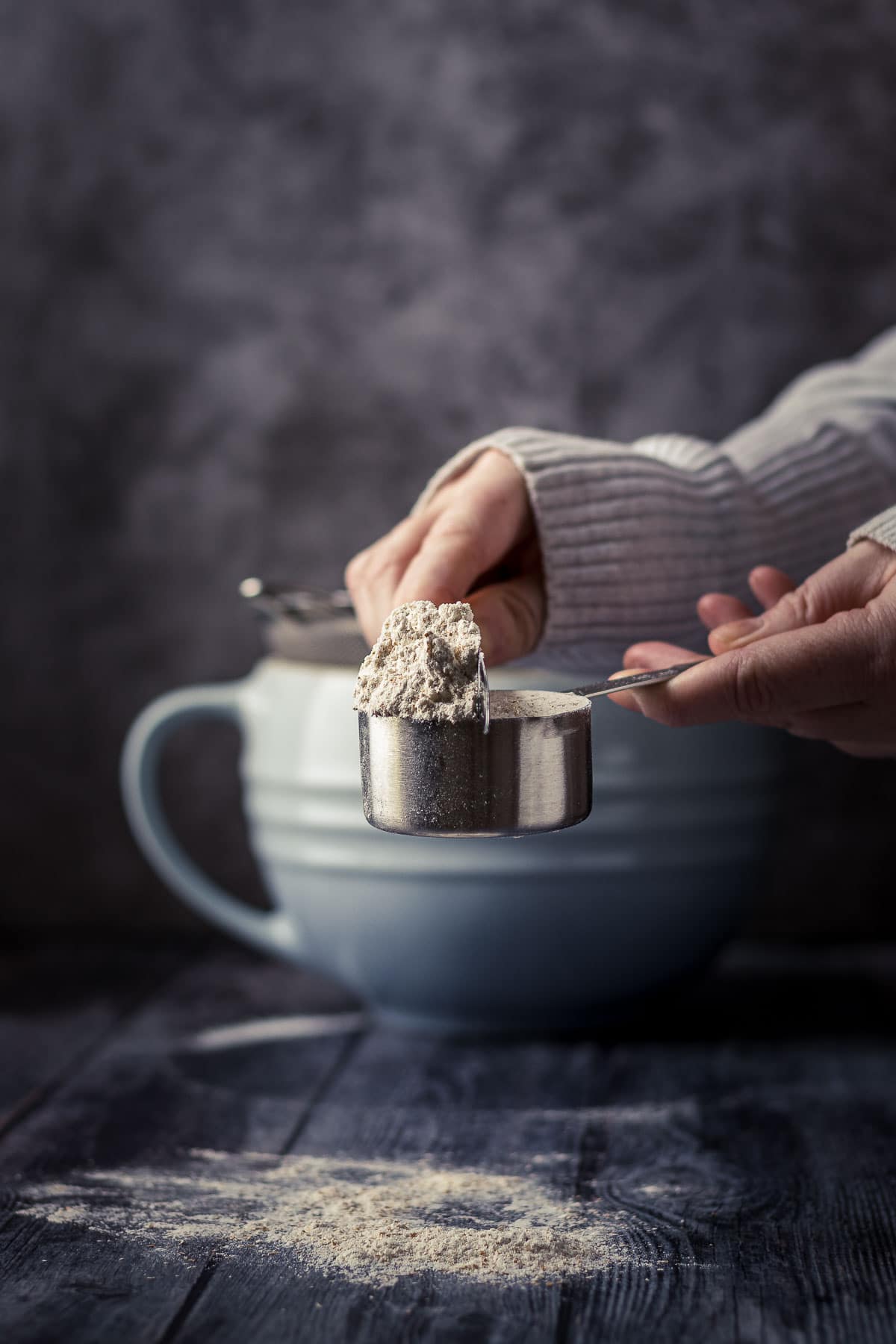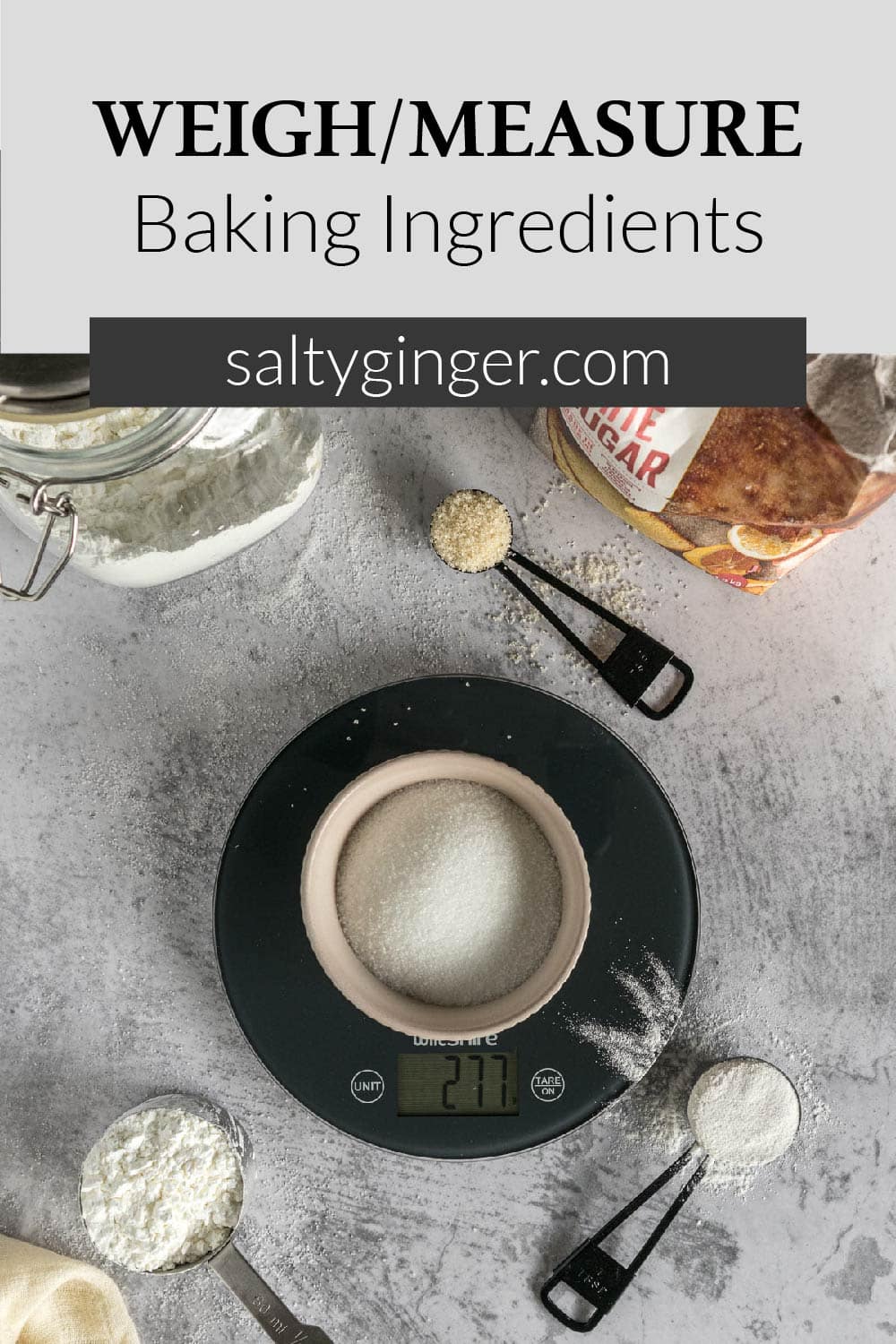Baking is a delicate mix of art and science. The first step in ensuring a great bake is accurately measuring ingredients.
When it comes to baking, weighing out ingredients is my preferred method. Not only is it more accurate, it generally results in fewer dishes when cleaning up.
However, I know that my readers use both scales and measuring cups. This is why I have a button on my recipe card to toggle from Metric to Cups. For the purpose of my recipes, a cup is equal to 240mL/8 fl oz, tablespoons are 15mL and teaspoons are 5mL.

Jump to:
Why is Accuracy so Important in Baking?
Baking is a delicate mix of art and science. In its most basic forms, a baked good is the end result of a series of chemical reactions that occur. These reactions are not only dependent on the ingredients but the methods used, as well as the temperature during the baking.
To start a baking endeavor off on the right foot, it's best, to begin with an accurate measurement of ingredients. And the quickest, easiest, and most accurate way to do this is with a kitchen scale. Simply because cups come in different sizes around the world (see below) and the fact that I will measure a cup of flour differently from you.
Kitchen scales remove this level of human error while taking away the guessing game of what size cup the author used.
That being said - because there is a bit of art to baking, I have made the personal decision to include conversions based on what I have learned over the last two years of running Salty Ginger.
And this also takes into consideration that scales, cups, and spoons used in homes are not laboratory quality with laboratory-required accuracy. And there is a little bit of leeway when it comes to cooking and baking. However, I do implore that when measuring ingredients with cups and spoons - do so as correctly as possible.
Not all Cups are Equal
So here is the thing with cups...they are not all equal. And cup measurements vary across the globe. This is also why different websites will have different gram measurements per cup.
- Metric cup = 250 mL/ 8.5 fl oz
- USA cup = 236.59 mL/8 fl oz (this is usually rounded up to 240 mL)
- Japanese cup = 200mL/6.5 fl oz
- Breakfast cup = 300 mL/ 10 fl oz
- Teacup = 150 mL/ 5 fl oz
- Scant cup = just shy of a full cup
- Heaping cup = is slightly more generous than a full cup
- ½ cup = 120mL/ 4 fl oz
- ¼ cup = 60mL/ 1 fl oz
For my metric users, when you next have a look at your set of measuring cups, check the measurement on the ½ and ¼ cups, you will see here that they will usually display 120mL and 60mL (if they display mL measurements). If this is the case - your 250 mL cup may actually only be 240 mL. Especially if buying mass-produced cups.
Note on my personal set of cups - I got curious and wondered exactly how accurate my set of cups was. So I weighed how much water went into my cup...and that is when it dawned on me that my 250 mL labeled cup was actually only 240 mL. It makes sense because it really is only a 10 mL difference. Logically all the cups are probably mass-produced for both the US and metric markets in the same factory, and within allowable error margins.
Liquid measuring cups will usually have mL measurements on one side of the jug, and have a cup and fluid ounce measurements on the other side. These cup measurements will usually correspond to USA cup sizes.
Not all Spoons are Equal
And well, spoons are not equal either. And here I must insist that a set of measuring spoons. Regular cutlery teaspoons, tablespoons, and dessert spoons vary greatly in size. I have 3 different cutlery teaspoons and measurements from these teaspoons can vary up to 70% difference between spoons and how heaped the ingredients actually are on the spoon.
- 2 tablespoons = 30 mL = 1 fl oz (⅛ cup)
- 1 tablespoon = 15 mL = ½ fl oz
- 1 Australian tablespoon = 20 mL
- 1 dessert spoon = 10 mL
- 1 teaspoon = 5 mL
Neither are Pints or Gallons
- 1 US Gallon = 3800 mL / 3.8L
- 1 UK Gallon = 4500 mL / 4.5L
- 1 US Pint = 454 mL / 16 fl oz
- 1 UK Pint = 575 mL/ 20 fl oz
Let's Talk Eggs
If you have ever come across a weight measurement for eggs - it's there for a good reason. The outcome of that specific recipe (think souffle or macrons) depends on the exact amount of ingredients. And the weight measurement is used because well - not all the eggs in the tray will be the same size.
Why? To make it simpler for egg suppliers, many countries require a total weight per tray/dozen to be a certain weight to be graded a certain size. This means that sometimes one of the eggs is visibly smaller or larger than the rest in the tray.
And then to complicate matters even more...sizes of eggs vary across the globe as well. I bake with size 6 (standard eggs here in New Zealand) which are around the same size as Australian and South African Large Eggs, but closer to a US/Europe Medium. See the egg sizes below, these have been taken from Wikipedia and cross-checked with a few other sites.
| Size | USA | Europe | Aus | NZ | SA |
| Jumbo (8) | 70.9 g | - | 68 g | 68 g | 66 g |
| X-Large | 63.8 g | 73 g | 60 g | - | 59 g |
| Large (7) | 56.8 g | 63 g | 52 g | 62 g | 51 g |
| Standard (6) | - | - | - | 53 g | - |
| Medium (5) | 49.6 g | 53 g | 43 g | 44 g | 43 g |
How to Properly Measure Ingredients Using a Kitchen Scale
Most kitchen scales are digital, and many allow you to choose grams, ounces, fluid ounces, and milliliters (mL). Be cautioned that the fluid ounces and mL are only accurate for water.
The kitchen scale should be placed directly onto the kitchen counter or table (nothing underneath the scale please). Place your bowl onto the scale and press tare (this zero's out the scale). Then add in your ingredient, if you add too much, use a spoon to remove it until you have the desired weight.
For analog kitchen scales, there will usually have a dial underneath the bowl. This can be used to tare the scale or bowl that is being used to weigh the ingredients.
I've linked a basic kitchen scale below.
Can I add more than one ingredient to the same bowl?
Yes! Once you become more comfortable using a kitchen scale, you can add more than one ingredient to a bowl. Simply tare between ingredients to zero out the scale.
For example, when I'm making crunchies or Anzac biscuits, I weigh out all the ingredients into a large mixing bowl. I will try to portion out the ingredients into different quadrants which allows me to remove the top layer should I be over a few grams.
Weighing out bread dough or cookie batter
For even-sized cookies or buns - it may help to weigh out individual portions. For this, I like to place a piece of baking paper on top of my scale if I'm not using a bowl to keep my kitchen scale clean.
General Baking Conversions Used on Salty Ginger
I needed to come up with an easy way allow me to convert from grams to cups for my readers. My decision is solely based on what is easy for me and what is easy for my readers. For me, it would be to start with my recipe card which allows for me to do fairly easy conversions. And because I feel there is not much difference between a US cup and a Metric cup...I decided to just go with a US customary cup.
| INGREDIENT | 1 CUP | 1 TBSP |
| Flour (plain, all-purpose)*see note | 125 grams | 8 grams |
| White Sugar | 200 grams | 13 grams |
| Brown Sugar | 220 grams | 14 grams |
| Icing Sugar | 125 grams | 8 grams |
| Cocoa Powder | 86 grams | 5 grams |
| Butter/Oil | 227 grams | 14 grams |
| 1 Stick of Butter (½ cup) | 113 grams | 14 grams |
| Milk | 244 grams | 15 grams |
| Yogurt/Sour Cream | 245 grams | 15 grams |
| Water | 236 grams | 15 grams |
| Chocolate Chips | 180 grams | 11 grams |
| Nuts | 95 grams | 6 grams |
| Cream Cheese | 226 grams | 14 grams |
| Chopped Dates | 120 grams | 8 grams |
| Rolled Oats | 100 grams | 6 grams |
| Desiccated Coconut | 95 grams | 6 grams |
| Honey/Syrup | 340 grams | 21 grams |
Note* The weight of flour in a US customary cup is split between 120 and 125 grams. In most recipes, 5 grams will not make a difference, so it's much of a muchness really.
| CUPS | Metric mL | FL.OZ | US mL |
| 4 | 1000 | 33 (32) | 960 |
| 1 | 250 | 8 | 240 |
| ¾ | 190 | 6 | 180 |
| ⅔ | 170 | 5 | 160 |
| ½ | 125 | 4 | 120 |
| ⅓ | 85 | - | 80 |
| ¼ | 65 | 2 | 60 |
| ⅛ | 30 | 1 | 30 |
| 1 tbsp | 15 | ½ | 15 |
| 1 tsp | 5 | - | 5 |
| Cookie Scoop Size | Cups/Spoons | mL | Use |
| 12 | ⅓ cup | 80 | Muffins/Portions |
| 16 | ¼ cup | 60 | Muffin / Cupcake |
| 24 | 2 ⅔ tbsp | 40 | Cookie |
| 30 | 2 tbsp | 30 | Cookie |
| 40 | 1 ⅔ tbsp | 25 | Cookie |
| 60 | 1 tbsp | 15 | |
| 100 | 1 ½ tsp | 22 |
How to properly measure ingredients using cups
Even though there is a bit of leeway when it comes to baking, and many of my recipes are fine with being a few grams off (if they weren't, I would make notes of this in the recipe), it is important that you measure out ingredients properly when using cups and spoons.

When do I sift ingredients?
When the recipe calls for it. However, if your cocoa powder is lumpy, toss it through a sieve to ensure all the lumps are removed.
If a recipe says 1 cup of flour/icing sugar/cocoa powder, sifted - measure out the ingredient and then sift it.
If a recipe says 1 cup of sifted flour/icing sugar/cocoa powder - sift and then measure.
Flour, Icing Sugar & Cocoa Powder: Spoon and Level
Because finer ingredients like flour, icing sugar, and cocoa powder are light and less dense than white or brown sugar, they can be easily compacted. Because of this, incorrect measurement (scooping out of the container or tapping the cup) can result in up to 50% more of the ingredient than the recipe called for. This means that if a recipe calls for 1 cup of flour - you could be adding up to an extra half a cup of flour.
This is how I spoon and level:
- Fluff up the ingredients in their container (giving a bit of shake, stirring around with a spoon)
- Spoon the ingredient into the cup.
- Level the ingredient using the back of a knife.
Baking Powder and Baking Soda (Bicarbonate of Soda or Bread Soda)
I like to give my baking powder and baking soda containers a bit of a shake/stir before I take my measuring spoon and scoop and level off my measurement.
Both these ingredients have a fairly short life span, to test the viability, a ½ teaspoon into a cup or bowl. Pour about a ¼ cup of boiling water over the baking powder. If it foams and bubbles it is still fresh.
White Sugar: Scoop and Level
White sugar is measured by scooping it into the container and pulling up a heaping cup and then leveling it off with the back of a knife. Why? Sugar is heavier (more dense) than flour and won't compress in the same way that flour will.
Brown Sugar: Scoop, Pack, and Level
Brown sugar should be scooped out of the container and packed into the cup or measuring spoon and then leveled off with the back of a knife.
Liquids: Oil, Water, Milk
These should be measured using liquid measuring cups or jugs. Once an ingredient has been added to the measuring cup, on a counter, bend down until you are at eye level with the ingredient. The bottom of the meniscus should be in line with the measurement.
Thick Liquid Sweeteners: Honey, Syrup, etc
Spray your dry measuring cup or spoon with nonstick spray and then pour your sweetener into the measuring cups.
Thick Semi-Liquids - Yogurt, Peanut Butter, Sour Cream
Because of the thickness of these ingredients, use your dry measuring cups. Spoon the ingredient into the cup and level off with the back of a knife.
Butter
Butter is usually sold in blocks or sticks across the world. Luckily, most blocks of butter also come with increment measurements on the paper for easy measurements.
Metric blocks of butter typically weigh 500 grams. While sticks of butter usually weigh around 113 grams or ½ cup. Yip - you are correct, a half cup of butter is different when it comes to metric vs US cups.
Nuts, Chocolate Chips, Sprinkles, Etc
Other ingredients that are added to the baked goods such as chocolate, nuts, sprinkles, or even chopped fruit can be scooped into a dry measuring cup.


Comments
No Comments